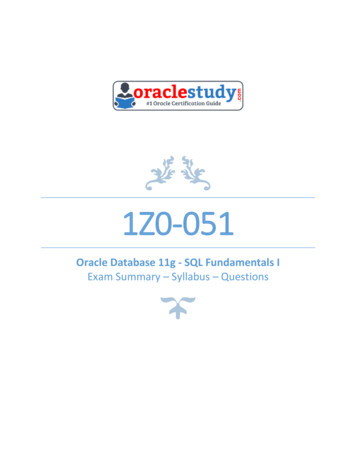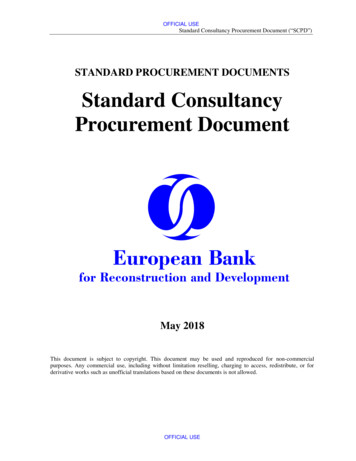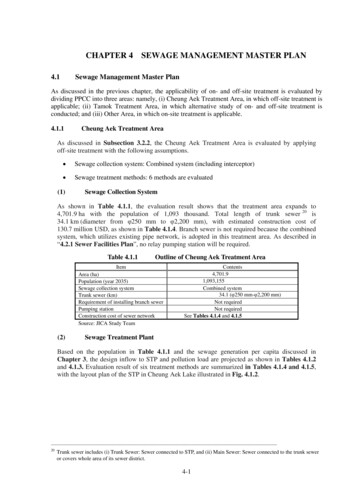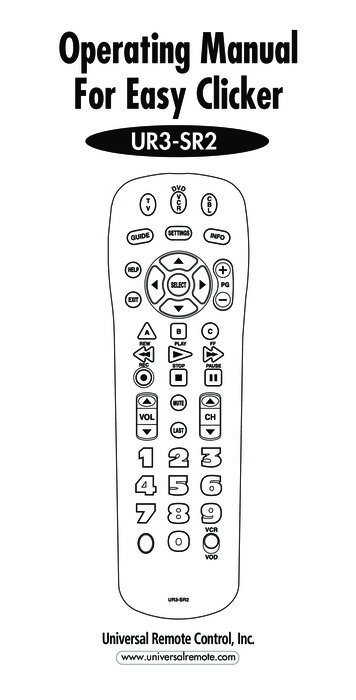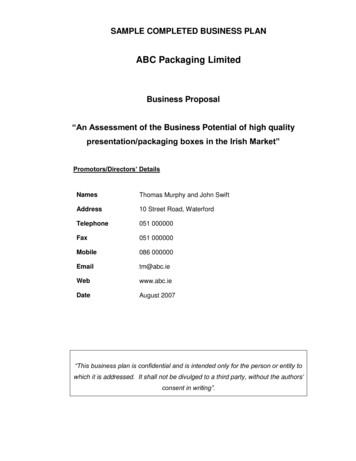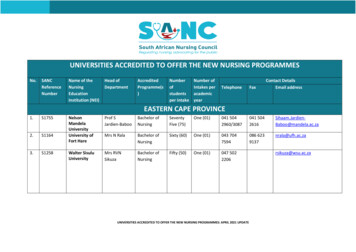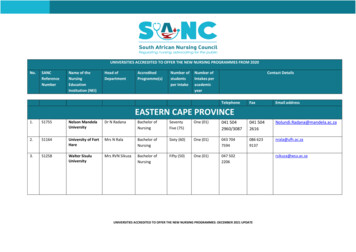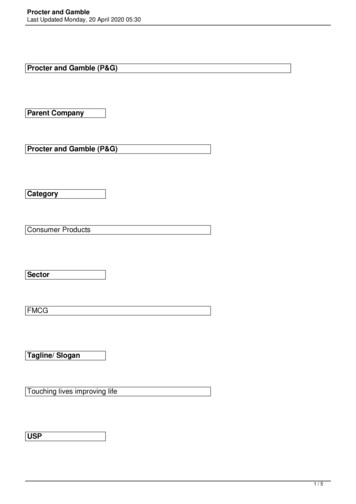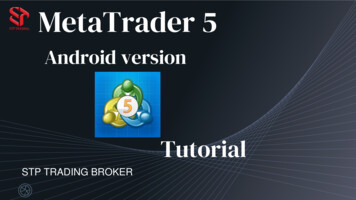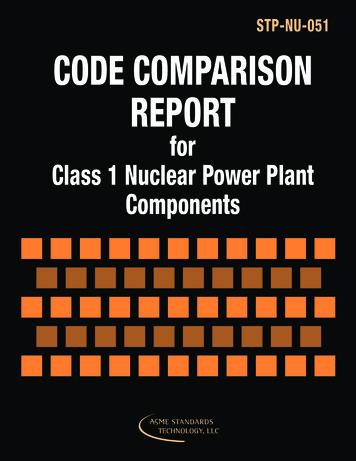
Transcription
STP-NU-051CODE COMPARISONREPORTforClass 1 Nuclear Power PlantComponents
STP-NU-051CODE COMPARISONREPORTforClass 1 Nuclear Power PlantComponentsPrepared for:Multinational Design Evaluation ProgrammeCodes and Standards Working Group
Date of Issuance: January 27, 2012This report is the result of a multi-national effort by Standards Development Organizations (SDOs) fromthe United States of America, France, Japan, Korea and Canada.Neither ASME, ASME ST-LLC, the contributors, nor others involved in the preparation or review of thisreport, nor any of their respective employees, members or persons acting on their behalf, makes any warranty,express or implied, or assumes any legal liability or responsibility for the accuracy, completeness or usefulnessof any information, apparatus, product or process disclosed, or represents that its use would not infringe uponprivately owned rights.Reference herein to any specific commercial product, process or service by trade name, trademark,manufacturer or otherwise does not necessarily constitute or imply its endorsement, recommendation orfavoring by ASME ST-LLC or others involved in the preparation or review of this report, or any agencythereof. The views and opinions of the authors, contributors, and reviewers of the report expressed herein do notnecessarily reflect those of ASME ST-LLC or others involved in the preparation or review of this report, or anyagency thereof.ASME ST-LLC does not take any position with respect to the validity of any patent rights asserted inconnection with any items mentioned in this document, and does not undertake to insure anyone utilizing apublication against liability for infringement of any applicable Letters Patent, nor assumes any such liability.Users of a publication are expressly advised that determination of the validity of any such patent rights, and therisk of infringement of such rights, is entirely their own responsibility.Participation by federal agency representative(s) or person(s) affiliated with industry is not to be interpretedas government or industry endorsement of this publication.ASME is the registered trademark of the American Society of Mechanical Engineers.No part of this document may be reproduced in any form,in an electronic retrieval system or otherwise,without the prior written permission of the publisher.ASME Standards Technology, LLCThree Park Avenue, New York, NY 10016-5990ISBN No. 978-0-7918-3419-0Copyright 2012 byASME Standards Technology, LLCAll Rights Reserved
Code Comparison ReportSTP-NU-051TABLE OF CONTENTSForeword . IXAbstract . X1INTRODUCTION . 11.1 Background and Scope . 11.2 Objectives . 11.3 Contents of the Report . 11.4 Comparison Scale . 22GENERAL PRESENTATION OF CODES . 42.1 Background Information on ASME. 42.2 Background Information on AFCEN . 92.3 Background Information on JSME . 152.4 Background Information on KEA. 222.5 Background Information on CSA . 263GENERAL CODE LAYOUT COMPARISONS . 343.1 RCC-M versus ASME General Layout Comparison . 343.2 JSME versus ASME General Layout Comparison . 363.3 KEPIC versus ASME General Layout Comparison . 393.4 CSA versus ASME General Layout Comparison . 404RCC-M VERSUS ASME BPVC SECTION III COMPARISON . 424.1 Abstract . 424.2 Introduction. 424.3 Preliminary Paragraphs and Scope Presentation. 434.4 Materials . 454.5 Design . 554.5.1 Piping, Valves and Pumps . 584.6 Fabrication – Welding . 624.7 Examination . 714.8 Pressure Tests . 764.9 Overpressure Protection. 774.10 Overview on Quality Aspects . 794.11 Conclusion . 805JSME VERSUS ASME BPVC SECTION III COMPARISON . 835.1 Abstract . 83iii
STP-NU-051Code Comparison Report5.2 Introduction . 835.3 Preliminary Paragraphs and Scope Presentation . 855.4 Materials . 855.5 Design . 865.5.1 Piping, Valves and Pumps . 895.6 Fabrication – Welding . 945.7 Examination . 965.8 Pressure Tests . 985.9 Overpressure Protection . 985.10 Overview on Quality Aspects . 995.11 Conclusion. 1006KEPIC VERSUS ASME BPVC SECTION III COMPARISON . 1046.1 Abstract . 1046.2 Introduction . 1046.3 Preliminary Paragraphs and Scope Presentation . 1056.4 Materials . 1066.5 Design . 1066.6 Piping, Valves and Pumps . 1066.7 Fabrication – Welding . 1076.8 Examination . 1076.9 Pressure Tests . 1076.10 Overpressure Protection . 1076.11 Overview on Quality Aspects . 1086.12 Conclusion. 1117CSA VERSUS ASME BPVC SECTION III COMPARISON . 1127.1 Abstract . 1127.2 Introduction . 1127.3 Preliminary Paragraphs and Scope Presentation . 1137.4 Materials . 1157.5 Design . 1167.5.1 Piping, Valves and Pumps . 1167.6 Fabrication – Welding . 1177.7 Examination . 1177.8 Pressure Tests . 1187.9 Overpressure Protection . 119iv
Code Comparison ReportSTP-NU-0517.10 Overview on Quality Aspects . 1207.11 Conclusion . 1208REFERENCES . 121Abbreviations and Acronyms . 122Appendix A: RCC-M Versus AME Section III Detailed Comparison Table . 124Appendix B: JSME Versus ASME Section III Detailed Comparison Table. 199Appendix C: KEPIC Versus ASME Section III Detailed Comparison Table . 235Appendix D: CSA N285 Versus ASME Section III Detailed Comparison Table. 322LIST OF TABLESTable 1—Codes General Layout Comparison. 34Table 2—Nuclear Island Components Section Layout . 35Table 3—JSME Design Code Organization and Section Titles . 37Table 4—Comparison of ASME NB and JSME Class 1 Rules . 38Table 5—Composition of KEPIC-MN and Reference Standards . 39Table 6—Composition of KEPIC-MNB and ASME NB . 39Table 7—List of the N285.0 . 41Table 8—Location in RCC-M of Paragraphs Equivalent to ASME Section III Division 1 NB1000 . 44Table 9—Location in ASME BPVC of Paragraphs Equivalent to RCC-M Section III B-1000Paragraphs . 44Table 10—Location in RCC-M of Paragraphs Equivalent to ASME Section III Division 1 NB2000 . 48Table 11—Location in ASME BPVC of Paragraphs Equivalent to RCC-M Paragraphs aboutMaterials from Sections I and II . 49Table 12—AFNOR 16MND5 (STR: M2111) as per RCC-M and SA-508 Grade 3 as per ASME– Specification for Quenched and Tempered Vacuum-Treated Carbon and Alloy SteelForgings for Pressure Vessels . 51Table 13—Comparison of Chemical Composition Requirements in M2111 for 16MND5 throughthe Years, and in SA-508 and in SA-788 for SA-508 Grade 3 Class 1 . 52Table 14—Charpy Impact Test Values for AFNOR 16MND5 (STR: M2111) as per RCC-M andSA-508 Grade 3 as per ASME . 52Table 15—Typical Material Specification Comparison for the RCC-M (left) and ASME (right) . 53Table 16—Location in ASME BPVC of Paragraphs Equivalent to RCC-M Paragraphs AboutDesign . 60Table 17—Both Codes Loading Category and Applied Criteria. 60Table 18—Factors of Safety for Ferritic Materials . 61v
STP-NU-051Code Comparison ReportTable 19—Location in RCC-M of Paragraphs Equivalent to ASME Section III Division 1 NB4000. 65Table 20—Location in ASME BPVC of Paragraphs Equivalent to RCC-M Paragraphs aboutWelding from Section IV . 66Table 21—Location in ASME BPVC of Paragraphs Equivalent to RCC-M Paragraphs aboutFabrication from Section V . 67Table 22—Location in RCC-M of Paragraphs Equivalent to ASME Section III Division 1 NB5000. 73Table 23—Location in ASME BPVC of Paragraphs Equivalent to RCC-M Paragraphs aboutFabrication from Section IV . 74Table 24—Radiographic Examination Acceptance Criteria for RCC-M and ASME BPVC . 75Table 25—Magnetic Particle Examination Acceptance Criteria for RCC-M and ASME BPVC . 75Table 26—Location in RCC-M of Paragraphs Equivalent to ASME Section III Division 1 NB6000. 77Table 27—Location in RCC-M of Paragraphs Equivalent to ASME Section III Division 1 NB7000. 78Table 28—Comparison of Plastic Analysis Between JSME Code Case and ASME . 89Table 29—Comparison of ASME NB and JSME Class 1 Rules . 93Table 30—Comparison Between ASME/JSME Allowable Primary Stress for Class 1 Piping . 93Table 31—Composition of KEPIC-MNB 1000 and ASME NB 1000 . 105Table 32—Composition of KEPIC-MNB and ASME NB . 106Table 33—Comparison Between KEPIC-QAR and ASME Sec. III Div. 1 Appendix XXIII . 108Table 34—Comparison for QA and Administrative Requirements . 109Table 35—Comparison for QA and Administrative Requirements . 109Table 36—Composition of KEPIC-MNB and ASME NB . 109Table 37—Comparison of Code Symbol System Between KEPIC and ASME . 110Table 38—Terminology Comparison Between KEPIC-MNA and ASME NCA . 110Table 39—Comparison Between KEPIC-QAP and ASME NQA-1 . 110Table 40—Equivalence Between the N285.0 and ASME NB-2000 . 115Table 41—Equivalence Between the N285.0 and ASME NB-3000 . 116Table 42—Equivalence Between the N285.0 and ASME NB-3400/-3500/-3600. 116Table 43—Equivalence Between the N285.0 and ASME NB-4000 . 117Table 44—Equivalence Between the N285.0 and ASME NB-5000 . 117Table 45—Equivalence Between the N285.0 and ASME NB-6000 . 118Table 46—Equivalence Between the N285.0 and ASME NB-7000 . 119Table 47— Equivalence Between the N285.0 and ASME NCA-4000 . 120vi
Code Comparison ReportSTP-NU-051LIST OF FIGURESFigure 1—ASME Section III Organization Chart . 6Figure 2—List of Standards Used in the ASME BPVC. 7Figure 3—AFCEN Organization Chart . 10Figure 4—AFCEN Codes. 11Figure 5—List of Standards Used in the RCC-M Code . 12Figure 6—Organization of JSME Main Committee. 16Figure 7—Organization of JSME Subcommittee on Nuclear Power . 16Figure 8—List of Latest JSME Nuclear Codes and Standards. 17Figure 9—List of Standards Used in the JSME Code . 18Figure 10—KEPIC Committee Organization Chart . 23Figure 11—KEPIC Codes and Standards List (based on 2010 Edition) . 24Figure 12—KEPIC Endorsement Status by Korea Ministries . 25Figure 13—Governance of the CSA Standards. 29Figure 14—CSA Standards Development Process . 30Figure 15—NSSC and TC Organization Chart . 31Figure 16—List of Standards . 32Figure 17—Comparison ASME and JSME Code Organization . 38Figure 18—Design Stress (Sm), Yield Stength (Sy) and Ultimate Strength (Su) Comparison ofTwo Carbon Steels, SA-508 Gr 3 Cl2 and 16MND5 (M2111) . 50Figure 19—Design Stress (Sm), Yield Stength (Sy), and Ultimate Strength (Su) Comparison ofTwo Carbon Steels, SA-336 Cl F316LN and Z2CND18-12 (M3301) . 50Figure 20—Ke vs. Sn/Sm Curves per ASME, RCC-M, JSME and Direct Calculation (Gurdal, PVP2009). 61Figure 21—Filler Material Reference Data Sheet Example for Filler Material Acceptance fromRCC-M Section IV S-2800 . 68Figure 22—Example of Documentation Sheets to Give for Welding Procedure Specification fromASME Section IX Nonmandatory Appendix B . 69Figure 23—Detailed Section-by-Section Comparison Between ASME BPVC Section III NBParagraphs and RCC-M Section I B Paragraphs . 81Figure 24—General Comparison Between ASME BPVC Section III NB Paragraphs and RCC-MSection I B Paragraphs . 82Figure 25—General Comparison Between ASME BPVC Section III NB Paragraphs and RCC-MSection I B Paragraphs in Percentages . 82Figure 26—Comparison of Detailed Requirements for NDE in ASME and JSME Codes. 86Figure 27—Comparison of Ke Factor Used in the Simplified Elastic-Plastic Analysis BetweenJSME and ASME . 88vii
STP-NU-051Code Comparison ReportFigure 28—Comparison of ASME NB and JSME Class 1 Rules . 93Figure 29—Comparison of Maximum Allowance Offset in Final Welded Joints Between JSMEand ASME. 95Figure 30—Comparison of Maximum Thickness of Weld Reinforcement Between JSME andASME . 96Figure 31—Comparison of Maximum Size of Rounded Indication Between JSME and ASME . 97Figure 32—Detailed Section-by-Section Comparison Between ASME BPVC Section III NBParagraphs and JSME S-NC1-2008 . 102Figure 33—General Comparison Between ASME BPVC Section III NB Paragraphs andJSME S-NC1-2008 . 103Figure 34—General Comparison Between ASME BPVC Section III NB Paragraphs andJSME S-NC1-2008 in Percentages . 103viii
Code Comparison ReportSTP-NU-051FOREWORDASME Standards Technology, LLC (ASME ST-LLC) appreciates the collaborative effort put forth byall those involved in the development of this report. The report is the result of a multi-national effortby Standards Development Organizations (SDOs) from the United States of America, France, Japan,Korea and Canada. We also acknowledge the nuclear regulatory authorities who supported this work,which was initiated with a global vision of codes and standards consistency.Established in 1880, the American Society of Mechanical Engineers (ASME) is a professional notfor-profit organization with more than 127,000 members promoting the art, science and practice ofmechanical and multidisciplinary engineering and allied sciences. ASME develops codes andstandards that enhance public safety, and provides lifelong learning and technical exchangeopportunities benefiting the engineering and technology community. Visit www.asme.org for moreinformation.The ASME Standards Technology, LLC (ASME ST-LLC) is a not-for-profit Limited LiabilityCompany, with ASME as the sole member, formed in 2004 to carry out work related to newlycommercialized technology. The ASME ST-LLC mission includes meeting the needs of industry andgovernment by providing new standards-related products and services, which advance the applicationof emerging and newly commercialized science and technology and providing the research andtechnology development needed to establish and maintain the technical relevance of codes andstandards. Visit www.stllc.asme.org for more information.ix
STP-NU-051Code Comparison ReportABSTRACTThe Multinational Design Evaluation Programme (MDEP) Code Comparison Project was initiated inlate 2006 in response to a request by the MDEP Codes and Standards Working Group (CSWG)formerly known as the Working Group on Component Manufacturing Oversight (WGCMO). TheCSWG invited the organizations responsible for development of major nuclear componentconstruction codes and standards, Standards Development Organizations (SDOs), to makepresentations regarding the requirements of their respective codes and standards pertaining to lightwater cooled nuclear power plants along with comparisons between those respective codes andstandards.In an effort to facilitate consistent design and manufacturing processes for Nuclear Power PlantClass 1 components among the ten MDEP countries, the CSWG requested the various SDOs todevelop a comparison of the requirements of their respective codes and standards and those of theothers.The SDOs from the USA, France, Japan, Korea and Canada (ASME, AFCEN, JSME, KEA,and CSA, respectively) agreed to participate in this code comparison project and developcomparisons of the requirements for Class 1 vessels, piping, pumps and valves.The objective of this report is to identify and summarize the differences between major internationalnuclear codes and standards for Class 1 equipment; namely those of AFCEN (RCC-M), ASME(Section III), CSA (N-285), JSME (S NC1) and KEA (KEPIC-MN).The reader is reminded that each of the codes is a set of consistent rules. The requirements of onearea may be, and often are, dependent on the requirements in other sections. Since a line-by-linecomparison has been done, it may be tempting to judge the entire code based on the differencesbetween these individual points, but this may not lead to a correct conclusion. This exercise identifiesthe different requirements of the different codes. It was not within the scope of this report to provideconclusions relative to the full implementation of the various Codes.x
Code Comparison Report1INTRODUCTION1.1Background and ScopeSTP-NU-051The Multinational Design Evaluation Programme (MDEP) Code Comparison Project was initiated inlate 2006 in response to a request by the MDEP Codes and Standards Working Group (CSWG)formerly known as the Working Group on Component Manufacturing Oversight (WGCMO). TheCSWG invited the organizations responsible for development of major nuclear componentconstruction codes and standards, Standards Development Organizations (SDOs), to makepresentations regarding the requirements of their respective codes and standards pertaining to lightwater cooled nuclear power plants along with comparisons between those respective codes andstandards.In an effort to facilitate consistent design and manufacturing processes among the 10 MDEP countriesfor Class 1 Nuclear Power Plant components, the CSWG requested the various SDOs to develop acomparison of the requirements of their respective codes and standards and those of the others.The SDOs from the USA, France, Japan, Korea and Canada (ASME, AFCEN, JSME, KEA,and CSA, respectively) agreed to participate in this code comparison project and developcomparisons of the requirements for Class 1 vessels, piping, pumps and valves. The SDO fromRussia (NIKIET) has since also joined in this effort, and is developing comparisons of the NIKIETPNAE-G-7 requirements to those of ASME Sectio
Appendix B: JSME Versus ASME Section III Detailed Comparison Table . 199 Appendix C: KEPIC Versus ASME Section III Detailed Comparison Table. 235 Appendix D: CSA N285 Versus ASME Section III Detailed Comparison Table. 322 LIST OF TABLES
